

Essential fatty acid. Essential fatty acids, or EFAs, are fatty acids that humans and other animals must ingest because the body requires them for good health but cannot synthesize them.[1] The term "essential fatty acid" refers to fatty acids required for biological processes but does not include the fats that only act as fuel.

Only two fatty acids are known to be essential for humans: alpha-linolenic acid (an omega-3 fatty acid) and linoleic acid (an omega-6 fatty acid).[2][3] Some other fatty acids are sometimes classified as "conditionally essential," meaning that they can become essential under some developmental or disease conditions; examples include docosahexaenoic acid (an omega-3 fatty acid) and gamma-linolenic acid (an omega-6 fatty acid). When the two EFAs were discovered in 1923, they were designated "vitamin F", but in 1929, research on rats showed that the two EFAs are better classified as fats rather than vitamins.[3] Functions[edit] In the body, essential fatty acids serve multiple functions. Alpha-Linolenic acid. Α-Linolenic acid (ALA) is an essential omega-3 fatty acid and organic compound found in seeds (chia, flaxseed, see also table below), nuts (notably walnuts), and many common vegetable oils.
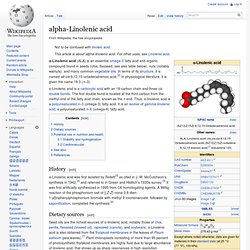
Linoleic acid. Linoleic acid (LA) is an unsaturated omega-6 fatty acid.
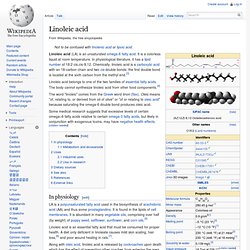
It is a colorless liquid at room temperature. In physiological literature, it has a lipid number of 18:2 cis,cis-9,12. Chemically, linoleic acid is a carboxylic acid with an 18-carbon chain and two cis double bonds; the first double bond is located at the sixth carbon from the methyl end.[3] A super-memory smart drug? Suppression of the PKR molecule in mutant mice (right) enhances learning and memory by lowering GABA release, compared to the process in "wild type" (normal) mice (left) (credit: BCM) Could this be the “Limitless” breakthrough we’ve been looking for?
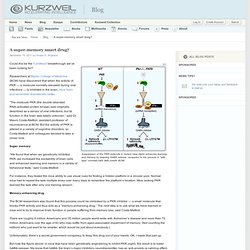
Researchers at Baylor College of Medicine (BCM) have discovered that when the activity of PKR — a molecule normally elevated during viral infections — is inhibited in the brain, mice learn and remember dramatically better. Environmental exposure to organochlorines may impact male reproduction. Melissa Perry, Sc.D., M.H.S., professor and chair of the Department of Environmental and Occupational Health at the GW School of Public Health and Health Services and adjunct associate professor at the Harvard School of Public Health, led an observational study indicating that environmental exposure to organochlorine chemicals, including Polychlorinated Biphenyls (PCBs) and p,p'-DDE (the main metabolite of the insecticide DDT) can affect male reproduction.

The research was published online on Dec. 21, 2011 in the journal Environmental Health Perspectives. The researchers studied 192 men who were part of couples that were sub-fertile, to see if the men with higher levels of organochlorines in their blood showed evidence of increased rates of sperm abnormalities. They looked for sperm disomy, which occurs when sperm cells have an abnormal number of chromosomes. The researchers used a new sperm imaging methodology developed by Dr.
Food additive. Food additives are substances added to food to preserve flavor or enhance its taste and appearance.
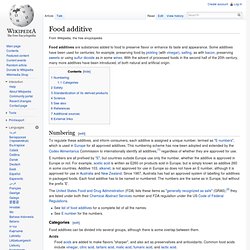
Some additives have been used for centuries; for example, preserving food by pickling (with vinegar), salting, as with bacon, preserving sweets or using sulfur dioxide as in some wines. With the advent of processed foods in the second half of the 20th century, many more additives have been introduced, of both natural and artificial origin. Numbering[edit] To regulate these additives, and inform consumers, each additive is assigned a unique number, termed as "E numbers", which is used in Europe for all approved additives. This numbering scheme has now been adopted and extended by the Codex Alimentarius Commission to internationally identify all additives,[1] regardless of whether they are approved for use.
E numbers are all prefixed by "E", but countries outside Europe use only the number, whether the additive is approved in Europe or not. Categories[edit] Acids Acidity regulators Antioxidants. Impact of alkalization on the antioxidant ... [J Agric Food Chem. 2008. Vitamin D and Prevention of Chronic Diseases. A hormone that fights fat with fat (10/12/2011) The fat we typically think of as body fat is called white fat.
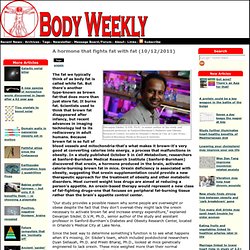
But there's another type-known as brown fat-that does more than just store fat. It burns fat. Scientists used to think that brown fat disappeared after infancy, but recent advances in imaging technology led to its rediscovery in adult humans. Enzymatic synthesis of pyrrolysine, the mysterious 22nd amino acid (11/24/2011) With few exceptions, all known proteins are built up from only twenty amino acids. 25 years ago scientists discovered a 21st amino acid, selenocysteine and ten years ago a 22nd, the pyrrolysine.

However, how the cell produces the unusual building block remained a mystery. Now researchers at the Technische Universitaet Muenchen have elucidated the structure of an important enzyme in the production of pyrrolysine. The scientific journal Angewandte Chemie reports on their results in its "Early View" online section. Proteins are key players in many vital processes in living organisms. They transport substances, catalyze chemical reactions, pump ions or recognize signaling molecules.